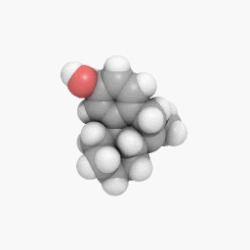Dextrorphan
Psychoactive cough suppressant medication From Wikipedia, the free encyclopedia
Dextrorphan (DXO) is a psychoactive drug of the morphinan class which acts as an antitussive or cough suppressant and in high doses a dissociative hallucinogen. It is the dextrorotatory enantiomer of racemorphan; the levorotatory enantiomer is levorphanol. Dextrorphan is produced by O-demethylation of dextromethorphan by CYP2D6. Dextrorphan is an NMDA antagonist and contributes to the psychoactive effects of dextromethorphan.[2]
 | |
 | |
| Clinical data | |
|---|---|
| Other names | DXO, Dextrorphanol |
| ATC code |
|
| Legal status | |
| Legal status |
|
| Identifiers | |
| |
| CAS Number | |
| PubChem CID | |
| ChemSpider | |
| UNII | |
| ChEMBL | |
| CompTox Dashboard (EPA) | |
| ECHA InfoCard | 100.004.323 |
| Chemical and physical data | |
| Formula | C17H23NO |
| Molar mass | 257.377 g·mol−1 |
| 3D model (JSmol) | |
| |
| |
| (what is this?) (verify) | |
Pharmacology
Summarize
Perspective
Pharmacodynamics
| Site | Ki (nM) | Species | Ref |
|---|---|---|---|
| NMDAR (MK-801) | 486–906 | Rat | [4] |
| σ1 | 118–481 | Rat | [4] |
| σ2 | 11,325–15,582 | Rat | [4] |
| MOR | 420 >1,000 | Rat Human | [4][7] |
| DOR | 34,700 | Rat | [4] |
| KOR | 5,950 | Rat | [4] |
| SERT | 401–484 | Rat | [4] |
| NET | ≥340 | Rat | [4] |
| DAT | >1,000 | Rat | [4] |
| 5-HT1A | >1,000 | Rat | [4] |
| 5-HT1B/1D | 54% at 1 μM | Rat | [4] |
| 5-HT2A | >1,000 | Rat | [4] |
| α1 | >1,000 | Rat | [4] |
| α2 | >1,000 | Rat | [4] |
| β | 35% at 1 μM | Rat | [4] |
| D2 | >1,000 | Rat | [4] |
| H1 | 95% at 1 μM | Rat | [4] |
| mAChRs | 100% at 1 μM | Rat | [4] |
| nAChRs | 1,300–29,600 (IC50) | Rat | [4] |
| VDSCs | ND | ND | ND |
| Values are Ki (nM), unless otherwise noted. The smaller the value, the more strongly the drug binds to the site. | |||
The pharmacology of dextrorphan is similar to that of dextromethorphan (DXM). However, dextrorphan is much more potent as an NMDA receptor antagonist and much less active as a serotonin reuptake inhibitor, but retains DXM's activity as a norepinephrine reuptake inhibitor.[8] It also has more affinity for the opioid receptors than dextromethorphan, significantly so at high doses.
Pharmacokinetics
Dextrorphan has a notably longer elimination half-life than its parent compound, and therefore has a tendency to accumulate in the blood after repeated administration of normally dosed dextromethorphan formulations.[citation needed] It is further converted to 3-HM by CYP3A4 or glucuronidated.[9]
Society and culture
Legal status
Dextrorphan was formerly a Schedule I controlled substance in the United States, but was unscheduled on October 1, 1976.[10]
Research
Dextrorphan was under development for the treatment of stroke, and reached phase II clinical trials for this indication, but development was discontinued.[11]
Environmental presence
In 2021, dextrorphan was identified in >75% of sludge samples taken from 12 wastewater treatment plants in California. The same study associated dextrorphan with estrogenic activity by using predictive modelling, before observing it in in vitro.[12]
See also
References
Wikiwand - on
Seamless Wikipedia browsing. On steroids.
